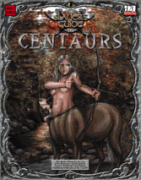
|
About OgreCave and its staff
|

|
by Joe G. Kushner
For example, the centaurs are supposed to be a good aligned race that nurtures the forest. If your party of paladins includes a half orc though, they'll shoot you down before you can make a protest. In addition, if the male centaurs get too drunk, they can cause damage to the forest. On one hand, because of their incredible isolationist methods, their aggression is understandable. Still, to kill without warning and to damage those things you protect and continue with that behavior at a latter date is not a good aligned thing, but rather, a neutral one. Like previous books, there is little on religion. Each village has it's own deities, and if not for the example village, there would be no example deities whatsoever. This is unfortunate, because the book could showcase the different aspects of nature instead of just ducking out on the religion issue. In addition, while the centaurs have primitive weaponry, mostly clubs, lances, spears, and bows, they are renowned for their bow making abilities, which are supposedly even greater than those bows of elven craft. Do they use any special woods, methods, or techniques? We'll never know. Do these bows have any bonuses? Once again, due to a dearth of game-mechanics, we'll never know. Centaurs are famous for their battle charges, but there are no feats or game mechanics to incorporate these events into your own game. To ease the GM in incorporating these creatures into the campaign, there are numerous adventure seeds. Unfortunately, the sample village, Lanhyd, follows the path of isolation to the extreme and makes them very difficult to insert into the campaign. In addition, almost all of these centaurs have classes, making them very powerful. Worse, while there is a map, there is no map key. Not really necessary for such a small village, but it would've been helpful. For game mechanics, the author apparently does not agree with race creation rules from the DMG where any creature above 1 hit die uses it's normal starting hit dice and gains skill points and feats based on that. Instead, we are shown a race where men and women have a +2 to strength and constitution, and a -4 to intelligence with a favored class of ranger. Now normally this wouldn't be an issue if the book didn't refer time and time again to women centaurs being smarter and taking the path of the druid. I would recommend that the +2 to strength be dropped and the -4 to intelligence be modified to -2 for females with a favored class of druid. While's it's perfectly understandable why the author might want to go another route for creating player characters out of the centaur race, what isn't so understandable is why they didn't follow their own mechanics. For example, centaurs are supposed to start with three extra hit dice but only one of the pregenerated centaurs has these bonus hit dice. In addition, each centaur has a challenge rating of one greater than their level, which seems to strongly indicate that at minimum, a centaur should be considered a 2nd level character. As for the layout, the book follows the standard with two columns of text. There are numerous stories that illustrate the centaur lifestyle. The interior art is fairly strong with numerous line illustrations of the centaurs in various actions. In all cases, they use no armor and stick with primitive weapons. The interior cover is that of a centaur with bone and muscle structure outlined. The rear interior cover is a map of Lanhyd, an untypical centaur village that GMs may appropriate for their own game. Because there are so few game-mechanics, the book is perfect for players of GURPS Fantasy or Palladium Fantasy who want to expand the role of centaur in their campaigns. Note that even with this book, the GM will still have to invent heroes, magic items, deities, and special weapons and amour to fully flesh out the centaurs. However, players of the d20 system looking for new crunchy bits will be disappointed. Still, at $7.99 it is one of the lower priced sourcebooks and has many useful seeds that can last for several adventures.
|
||
 Like the previous two books in the
Slayer's Guide series, this book has a singular focus, that of
making the centaur race a more interesting part of any campaign world.
Like previous books, this one is heavy on role playing material and
light on d20 game mechanics. Unlike other books though, there are often
some contradicting messages here.
Like the previous two books in the
Slayer's Guide series, this book has a singular focus, that of
making the centaur race a more interesting part of any campaign world.
Like previous books, this one is heavy on role playing material and
light on d20 game mechanics. Unlike other books though, there are often
some contradicting messages here.